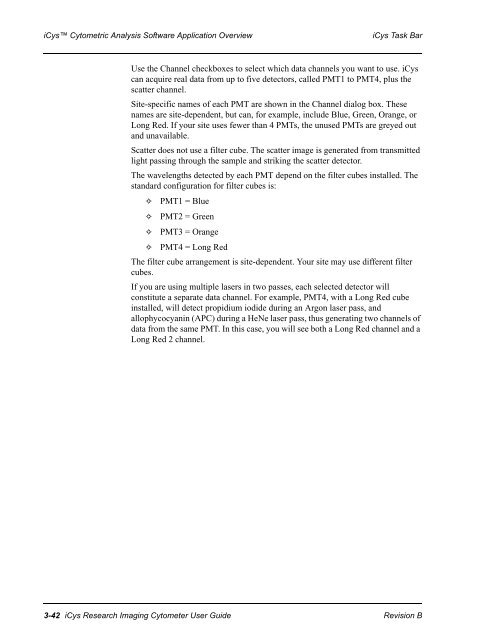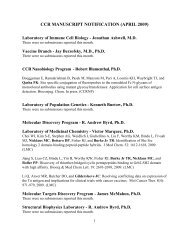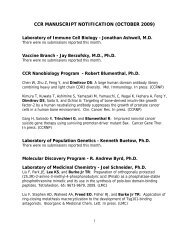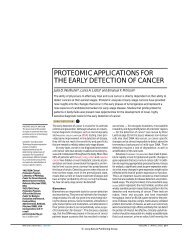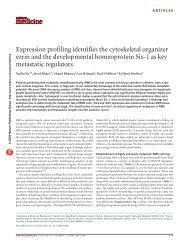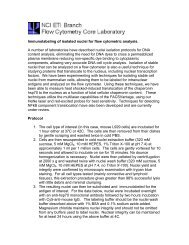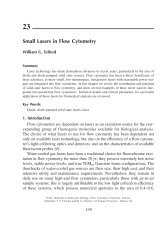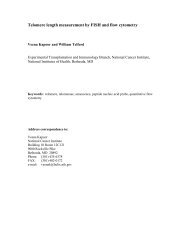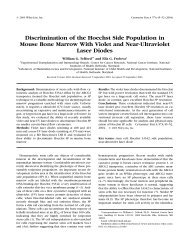- Page 1 and 2:
User Guide DOC190-0037-001 Revision
- Page 3 and 4:
Contents Chapter 1 Introduction Man
- Page 5 and 6:
May 6, 2005 Contents iCys Status Ba
- Page 7 and 8:
May 6, 2005 Contents Appendix B Usi
- Page 9 and 10:
Chapter 1 Introduction This manual
- Page 11 and 12:
May 6, 2005 Introduction System Ove
- Page 13 and 14:
Chapter 2 iCys Research Imaging Cyt
- Page 15 and 16:
May 6, 2005 iCys Research Imaging C
- Page 17 and 18:
May 6, 2005 iCys Research Imaging C
- Page 19 and 20:
May 6, 2005 iCys Research Imaging C
- Page 21 and 22:
May 6, 2005 iCys Research Imaging C
- Page 23 and 24:
May 6, 2005 iCys Research Imaging C
- Page 25 and 26:
May 6, 2005 iCys Research Imaging C
- Page 27 and 28:
May 6, 2005 iCys Research Imaging C
- Page 29 and 30:
May 6, 2005 iCys Research Imaging C
- Page 31 and 32:
May 6, 2005 iCys Research Imaging C
- Page 33 and 34:
May 6, 2005 iCys Research Imaging C
- Page 35 and 36:
May 6, 2005 iCys Research Imaging C
- Page 37 and 38: May 6, 2005 iCys Research Imaging C
- Page 39 and 40: May 6, 2005 iCys Research Imaging C
- Page 41 and 42: May 6, 2005 iCys Research Imaging C
- Page 43 and 44: May 6, 2005 iCys Research Imaging C
- Page 45 and 46: May 6, 2005 iCys Research Imaging C
- Page 47 and 48: Chapter 3 iCys Cytometric Analysis
- Page 49 and 50: May 6, 2005 iCys Cytometric Analysi
- Page 51 and 52: May 6, 2005 iCys Cytometric Analysi
- Page 53 and 54: May 6, 2005 iCys Cytometric Analysi
- Page 55 and 56: May 6, 2005 iCys Cytometric Analysi
- Page 57 and 58: May 6, 2005 iCys Cytometric Analysi
- Page 59 and 60: May 6, 2005 iCys Cytometric Analysi
- Page 61 and 62: May 6, 2005 iCys Cytometric Analysi
- Page 63 and 64: May 6, 2005 iCys Cytometric Analysi
- Page 65 and 66: May 6, 2005 iCys Cytometric Analysi
- Page 67 and 68: May 6, 2005 iCys Cytometric Analysi
- Page 69 and 70: May 6, 2005 iCys Cytometric Analysi
- Page 71 and 72: May 6, 2005 iCys Cytometric Analysi
- Page 73 and 74: May 6, 2005 iCys Cytometric Analysi
- Page 75 and 76: May 6, 2005 iCys Cytometric Analysi
- Page 77 and 78: May 6, 2005 iCys Cytometric Analysi
- Page 79 and 80: May 6, 2005 iCys Cytometric Analysi
- Page 81 and 82: May 6, 2005 iCys Cytometric Analysi
- Page 83 and 84: May 6, 2005 iCys Cytometric Analysi
- Page 85 and 86: May 6, 2005 iCys Cytometric Analysi
- Page 87: May 6, 2005 iCys Cytometric Analysi
- Page 91 and 92: May 6, 2005 iCys Cytometric Analysi
- Page 93 and 94: May 6, 2005 iCys Cytometric Analysi
- Page 95 and 96: May 6, 2005 iCys Cytometric Analysi
- Page 97 and 98: May 6, 2005 iCys Cytometric Analysi
- Page 99 and 100: May 6, 2005 iCys Cytometric Analysi
- Page 101 and 102: May 6, 2005 iCys Cytometric Analysi
- Page 103 and 104: May 6, 2005 iCys Cytometric Analysi
- Page 105 and 106: May 6, 2005 iCys Cytometric Analysi
- Page 107 and 108: May 6, 2005 iCys Cytometric Analysi
- Page 109 and 110: May 6, 2005 iCys Cytometric Analysi
- Page 111 and 112: May 6, 2005 iCys Cytometric Analysi
- Page 113 and 114: May 6, 2005 iCys Cytometric Analysi
- Page 115 and 116: May 6, 2005 iCys Cytometric Analysi
- Page 117 and 118: May 6, 2005 iCys Cytometric Analysi
- Page 119 and 120: May 6, 2005 iCys Cytometric Analysi
- Page 121 and 122: May 6, 2005 iCys Cytometric Analysi
- Page 123 and 124: May 6, 2005 iCys Cytometric Analysi
- Page 125 and 126: May 6, 2005 iCys Cytometric Analysi
- Page 127 and 128: May 6, 2005 iCys Cytometric Analysi
- Page 129 and 130: May 6, 2005 iCys Cytometric Analysi
- Page 131 and 132: May 6, 2005 iCys Cytometric Analysi
- Page 133 and 134: May 6, 2005 iCys Cytometric Analysi
- Page 135 and 136: May 6, 2005 iCys Cytometric Analysi
- Page 137 and 138: May 6, 2005 iCys Cytometric Analysi
- Page 139 and 140:
May 6, 2005 iCys Cytometric Analysi
- Page 141 and 142:
May 6, 2005 iCys Cytometric Analysi
- Page 143 and 144:
May 6, 2005 iCys Cytometric Analysi
- Page 145 and 146:
May 6, 2005 iCys Cytometric Analysi
- Page 147 and 148:
Chapter 4 Generating Analytical Dat
- Page 149 and 150:
May 6, 2005 Generating Analytical D
- Page 151 and 152:
May 6, 2005 Generating Analytical D
- Page 153 and 154:
May 6, 2005 Generating Analytical D
- Page 155 and 156:
May 6, 2005 Generating Analytical D
- Page 157 and 158:
May 6, 2005 Generating Analytical D
- Page 159 and 160:
May 6, 2005 Generating Analytical D
- Page 161 and 162:
May 6, 2005 Generating Analytical D
- Page 163 and 164:
May 6, 2005 Generating Analytical D
- Page 165 and 166:
May 6, 2005 Generating Analytical D
- Page 167 and 168:
May 6, 2005 Generating Analytical D
- Page 169 and 170:
May 6, 2005 Generating Analytical D
- Page 171 and 172:
May 6, 2005 Generating Analytical D
- Page 173 and 174:
May 6, 2005 Generating Analytical D
- Page 175 and 176:
May 6, 2005 Generating Analytical D
- Page 177 and 178:
May 6, 2005 Generating Analytical D
- Page 179 and 180:
May 6, 2005 Generating Analytical D
- Page 181 and 182:
May 6, 2005 Generating Analytical D
- Page 183 and 184:
May 6, 2005 Generating Analytical D
- Page 185 and 186:
May 6, 2005 Generating Analytical D
- Page 187 and 188:
May 6, 2005 Generating Analytical D
- Page 189 and 190:
May 6, 2005 Generating Analytical D
- Page 191 and 192:
May 6, 2005 Generating Analytical D
- Page 193 and 194:
May 6, 2005 Generating Analytical D
- Page 195 and 196:
May 6, 2005 Generating Analytical D
- Page 197 and 198:
Appendix A Installing iCys Research
- Page 199 and 200:
May 6, 2005 Installing iCys Researc
- Page 201 and 202:
May 6, 2005 Installing iCys Researc
- Page 203 and 204:
Appendix B Using the iNovator Toolk
- Page 205 and 206:
May 6, 2005 Using the iNovator Tool
- Page 207 and 208:
May 6, 2005 Using the iNovator Tool
- Page 209 and 210:
May 6, 2005 Using the iNovator Tool
- Page 211 and 212:
May 6, 2005 Using the iNovator Tool
- Page 213 and 214:
May 6, 2005 Using the iNovator Tool
- Page 215 and 216:
May 6, 2005 Using the iNovator Tool
- Page 217 and 218:
May 6, 2005 Using the iNovator Tool
- Page 219 and 220:
May 6, 2005 Using the iNovator Tool
- Page 221 and 222:
May 6, 2005 Using the iNovator Tool
- Page 223 and 224:
May 6, 2005 Using the iNovator Tool
- Page 225 and 226:
May 6, 2005 Using the iNovator Tool
- Page 227 and 228:
May 6, 2005 Using the iNovator Tool
- Page 229 and 230:
May 6, 2005 Using the iNovator Tool
- Page 231 and 232:
May 6, 2005 Using the iNovator Tool
- Page 233 and 234:
May 6, 2005 Using the iNovator Tool
- Page 235 and 236:
May 6, 2005 Using the iNovator Tool
- Page 237 and 238:
May 6, 2005 Using the iNovator Tool
- Page 239 and 240:
May 6, 2005 Using the iNovator Tool
- Page 241 and 242:
Appendix C Administrator Tasks This
- Page 243 and 244:
May 6, 2005 Administrator Tasks Dis
- Page 245 and 246:
May 6, 2005 Administrator Tasks Usi
- Page 247 and 248:
May 6, 2005 Administrator Tasks Def
- Page 249 and 250:
May 6, 2005 Administrator Tasks 5.
- Page 251 and 252:
May 6, 2005 Administrator Tasks The
- Page 253 and 254:
May 6, 2005 Administrator Tasks Det
- Page 255 and 256:
May 6, 2005 Administrator Tasks ❍
- Page 257 and 258:
May 6, 2005 Administrator Tasks The
- Page 259 and 260:
May 6, 2005 Administrator Tasks The
- Page 261 and 262:
May 6, 2005 Administrator Tasks ✧
- Page 263 and 264:
May 6, 2005 Administrator Tasks Det
- Page 265 and 266:
May 6, 2005 Administrator Tasks 5.
- Page 267 and 268:
May 6, 2005 Administrator Tasks Bef
- Page 269 and 270:
Appendix D Glossary This chapter co
- Page 271 and 272:
May 6, 2005 Glossary C carrier The
- Page 273 and 274:
May 6, 2005 Glossary EVT file An iC
- Page 275 and 276:
May 6, 2005 Glossary linear amplifi
- Page 277 and 278:
May 6, 2005 Glossary region A user-
- Page 279 and 280:
May 6, 2005 Glossary V voltage The


